Survey: 4. Politics Then and Now
We are only a couple weeks away from the mid-term elections — consequential elections being held during a time of extreme partisanship and vitriol. Certainly, our student days were fraught and very “political.”
Reasonable minds can differ as to whether 1968 or 2018 represents the worst case of division within the country. But now seems like a great time to report to you what the Class Survey said about our political opinions in 1969 and today.
Liberal vs. Conservative
Given the 50/50 public school vs. private school membership in our class and the viability of moderate “Rockefeller” Republicans in those days, it’s likely that we started our political journey somewhat liberal, but not “radical.” The arc of our college years likely pushed us leftward, but we never got as radical as other elite universities. Berkeley moved from free speech rallies to full-scale riots. See Crisis At Columbia published here last month. Consider the armed takeover by students at Cornell. And the year following our graduation, Yale escaped violence and damage during it’s Mayday rally for the Black Panthers, whereas Harvard suffered riots and millions of dollars in damages only a few weeks before Mayday, 1970.
That said, we were and are a liberal bunch. See the graph, next, which shows our self-described political views during our time at Yale and in the present. Back in 1969, 67 percent of us were liberals, 15 percent were ‘moderates,’ and the remaining 18 percent were conservatives. Most of the liberals do not describe themselves as having been ‘extremely liberal’ back then, but the leftward tilt of the class as a whole is obvious.
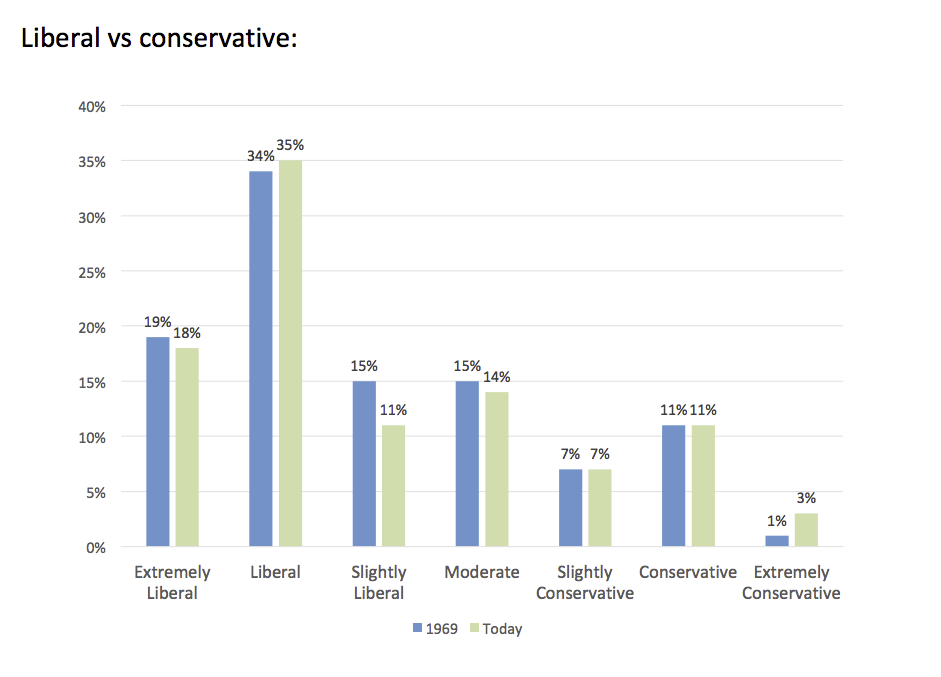 It is often presumed that people get more conservative as they age, but not so much for our class: today’s distribution of viewpoints is, compared to 1969, only very slightly more conservative (21 percent versus 18 percent in 1969). And 64 percent of us are still calling ourselves liberal, down from 67% in 1969.
It is often presumed that people get more conservative as they age, but not so much for our class: today’s distribution of viewpoints is, compared to 1969, only very slightly more conservative (21 percent versus 18 percent in 1969). And 64 percent of us are still calling ourselves liberal, down from 67% in 1969.
Democrat vs. Republican
Even though we got slightly more conservative, we definitely became less Republican: In 1969, 53 percent of us were Democrats, 24 percent were independents, and 20 percent were Republicans. (Libertarians, Greens, and other party labels accounted for the remaining three percent).
Today, Democrats have increased their share of our loyalties from 53 percent to 58 percent; an unchanged 24 percent self-identify as independents; but now only 14 percent say they are Republicans, down from 20% in 1969. (We offered the category of “Tea Party,” too, but nobody chose that label.) In fact, 50 percent of us Old Blues today call ourselves “strong Democrats,” contrasting starkly with just six percent identifying as “strong Republicans.” Hey, this could give a whole new meaning to the term “Blue wave.”
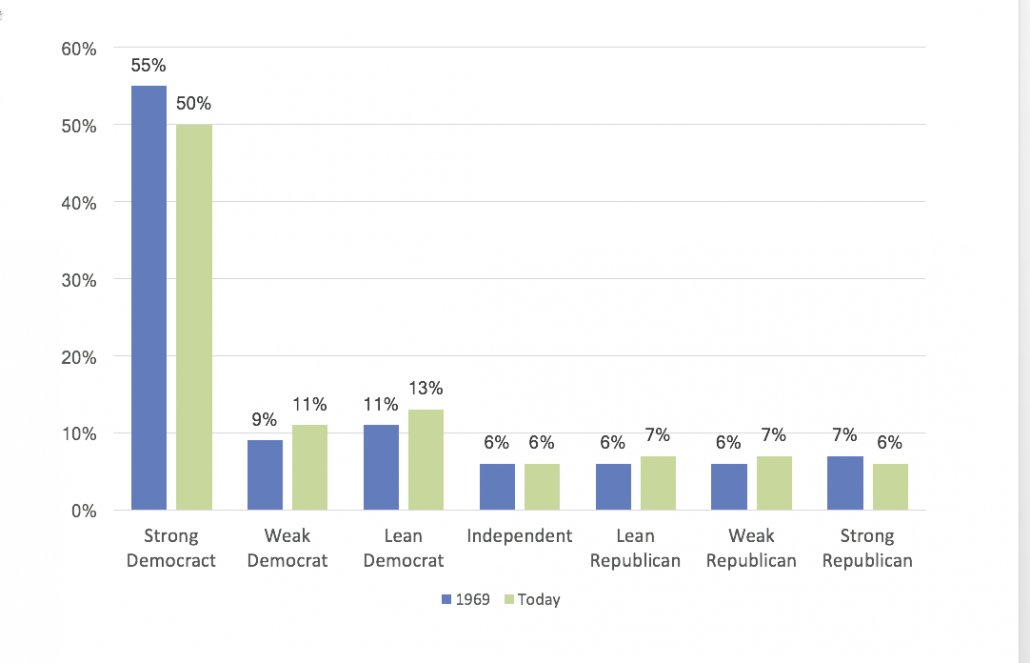
Vietnam
The Class Survey decided not to ask about current political questions such as immigration or presidential approval ratings, but we did ask about Vietnam, one of the two huge questions of our day (the other being Race). We asked first about the attitudes our classmates held in 1969; we then asked them to look back at the war from the present.
As seen next, based on our recall of 1969 and our self-reports, very few of us still thought of the war as “a noble cause” in our senior year of college, and 87 percent of us were against the war. Forty-one percent of us thought the war to be immoral, while a somewhat larger number (46 percent) saw the war as a mistake, but not immoral.
What Were Your Views of Vietnam (1969)

From our vantage point in the present, as seen next, there is less change in these opinions than one might have expected. Now 88 percent take the anti-war positions, compared to 87 percent in 1969, but among these the percent viewing the war as immoral has increased and fewer think of it as just a mistake. In both 1969 and in the present, the percent viewing the war as immoral is large but constitutes less than a majority of the class.
What Were Your Views of Vietnam (2018)
SSS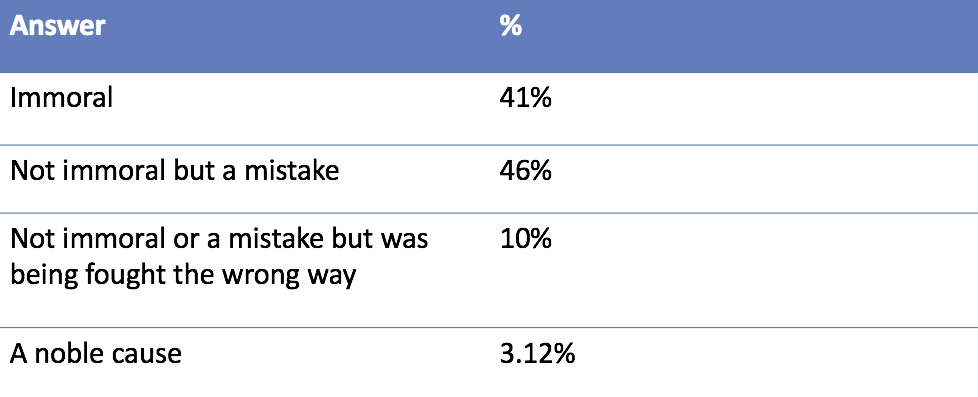
So, who’s Republican? Who’s a Democrat?
It’s often revealing to “slice and dice” survey results to find out more about which groups lean which way on some dimension. When it comes to party identification, the survey allows us to look at our classmates’ current affiliations as they relate to their high school background, their involvements in Yale back in the day, some things they did after college, and their present circumstances.
- As one might perhaps expect, those of us who went to prep school (that is, a private, residential preparatory school) are more likely to be Republicans than those who did not (20% compared to 12%, a statistically significant difference).
- Considering involvements at Yale, those who belonged to fraternities back then are more likely to be Republicans today (23%).
- The 70 survey respondents who said they participated in campus-wide publications (including WYBC) back then are now overwhelmingly Democrats (76% compared to 58% of the 475 others). (Don’t tell this to our current President, who will claim that we were subject to media bias even back then!)
- Seventy-three percent of the guys who participated in local volunteer or charity work at Yale are now Democrats, compared to 58% of those who didn’t.
- Neither being an athlete nor belonging to the Political Union, a musical group, or a senior society correlates significantly with current party ID.
- But one Yale activity stands out for its partisan aroma: 29% of guys who have never smoked marijuana are currently Republicans, compared to just 6% of all the others, including those who smoked the stuff back then and no longer do.
As for involvements after Yale:
- Having done military service is not significantly related to current party affiliation, and having served in the Peace Corps is only marginally related (with former vols leaning more Democratic).
- The big distinction is between men who say they have started one or more businesses in their life (20% currently Republican) versus the rest of us (6% Republican).
- And turning to our present circumstances, a related finding is that those of us who have achieved the greater level of wealth (net worth over $10 million) are 22% Republican, compared to 9% of those with less than $1 million in net assets. But when you get to the reunion, don’t prejudge anybody: keep in mind that even among this wealthier group (about one out of five in our class), 45% think of themselves as Democrats and 34% are Independents.
Survey statistics do slice and dice us, but in these contentious times, it’s good to recall all that we have in common as Yale classmates, including the fateful events of our college years that shaped the outlooks of so many of us for a lifetime. Not to speak of certain aromas . . .
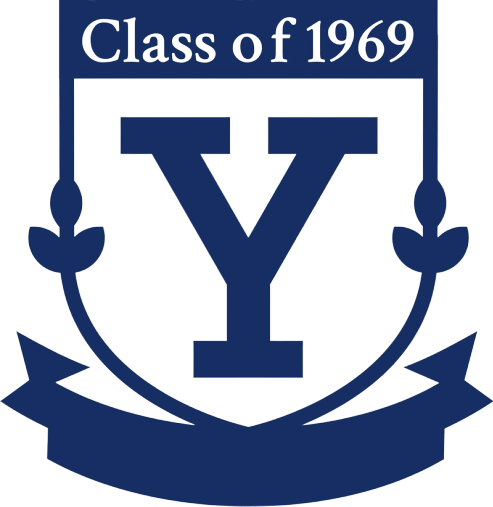
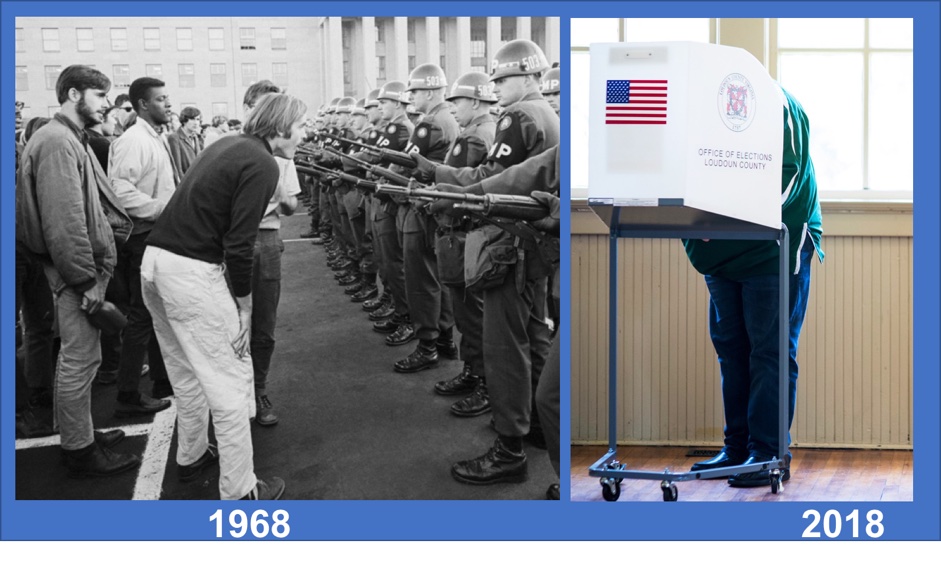
My My. Plus ca change . . . .
I find it very surprising, and a bit disappointing, that our political leanings — conservative versus liberal — have changed hardly an iota since 1969. Is that just faulty memory on our parts? Were we so set in our ways already in 1969? The relative proportions, then and now, are no surprise. I knew it then and know it now. I wonder if the composition of this year’s graduating class is “significantly” different. I would guess a little more liberal. Thanks, Thomas Guterbock, for compiling this very interesting information.
Glad to read that our class as we aged did not become more conservative. I was pleasantly surprised.
Hopefully, we have productive years ahead to help our communities and country compassionately and creatively deal with climate change, income inequality, racism, immigration and other challenges.
Rob Shlachter